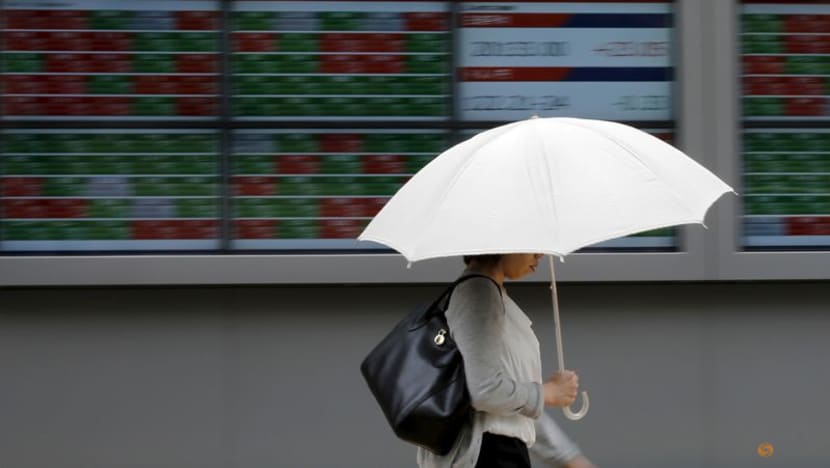Shares dip, oil up as investors wrestle with Iran risks

A woman holding a parasol walks past a stock quotation board outside a brokerage in Tokyo, on Jun 30, 2015. (Photo: REUTERS/Toru Hanai)
SYDNEY: Major share indexes slipped in Asia on Monday (Jun 23) and oil prices briefly hit five-month highs as investors anxiously waited to see if Iran would retaliate against US attacks on its nuclear sites, with resulting risks to global activity and inflation.
Most of the market moves were restrained, with the dollar getting a modest safe-haven bid and no sign of a rush to bonds. Oil prices were up around 1.5 per cent, but well off their initial peaks.
Optimists were hoping Iran might back down now its nuclear ambitions had been curtailed, or even that regime change might bring a less hostile government to power there.
"Markets may be responding not to the escalation itself, but to the perception that it could reduce longer-term uncertainty," said Charu Chanana, chief investment strategist at Saxo.
The Strait of Hormuz is only about 33km wide at its narrowest point and sees around a quarter of global oil trade and 20 per cent of liquefied natural gas supplies.
Analysts at JPMorgan, however, cautioned that past episodes of regime change in the region typically resulted in oil prices spiking by as much as 76 per cent and averaging a 30 per cent rise over time.
"Selective disruptions that scare off oil tankers make more sense than closing the Strait of Hormuz given Iran’s oil exports would be shut down too," said Vivek Dhar, a commodities analyst at Commonwealth Bank of Australia.
"In a scenario where Iran selectively disrupts shipping through the Strait of Hormuz, we see Brent oil reaching at least US$100/bbl."
Goldman Sachs warned prices could temporarily touch US$110 a barrel should the critical waterway be closed for a month.
For now, Brent was up a relatively restrained 1.4 per cent at US$78.07 a barrel, while US crude rose 1.4 per cent to US$74.88. Elsewhere in commodity markets, gold edged up 0.3 per cent to US$3,357 an ounce.
KEEP CALM AND CARRY ON
World share markets were proving resilient so far, with S&P 500 futures off just 0.1 per cent and Nasdaq futures down 0.2 per cent.
MSCI's broadest index of Asia-Pacific shares outside Japan fell 1 per cent, while Chinese blue chips dipped 0.2 per cent. Japan's Nikkei eased 0.2 per cent, though surveys showed manufacturing activity there returned to growth in June after nearly a year of contraction.
EUROSTOXX 50 futures lost 0.4 per cent, while FTSE futures fell 0.3 per cent and DAX futures slipped 0.4 per cent. Europe and Japan are heavily reliant on imported oil and LNG, whereas the United States is a net exporter.
The dollar gained 0.7 per cent on the Japanese yen to 147.07 yen , while the euro dipped 0.2 per cent to US$1.1497. The dollar index firmed marginally to 99.042.
There was also no sign of a rush to the traditional safety of Treasuries, with 10-year yields rising 2 basis points to 4.395 per cent.
Futures for Federal Reserve interest rates were a tick lower, likely reflecting concerns a sustained rise in oil prices would add to inflationary pressures at a time when tariffs were just being felt in US prices.
Markets are still pricing only a slim chance the Fed will cut at its next meeting on Jul 30, even after Fed Governor Christopher Waller broke ranks and argued for a July easing.
Most other Fed members, including Chair Jerome Powell, have been more cautious on policy leading markets to wager a cut is far more likely in September.
At least 15 Fed officials are speaking this week, and Powell faces two days of questions from lawmakers, which is certain to cover the potential impact of President Donald Trump's tariffs and the attack on Iran.
The Middle East will be high on the agenda at a NATO leaders meeting at the Hague this week, where most members have agreed to commit to a sharp rise in defence spending. Among the economic data due are figures on US core inflation and weekly jobless claims, along with early readings on June factory activity from across the globe.















